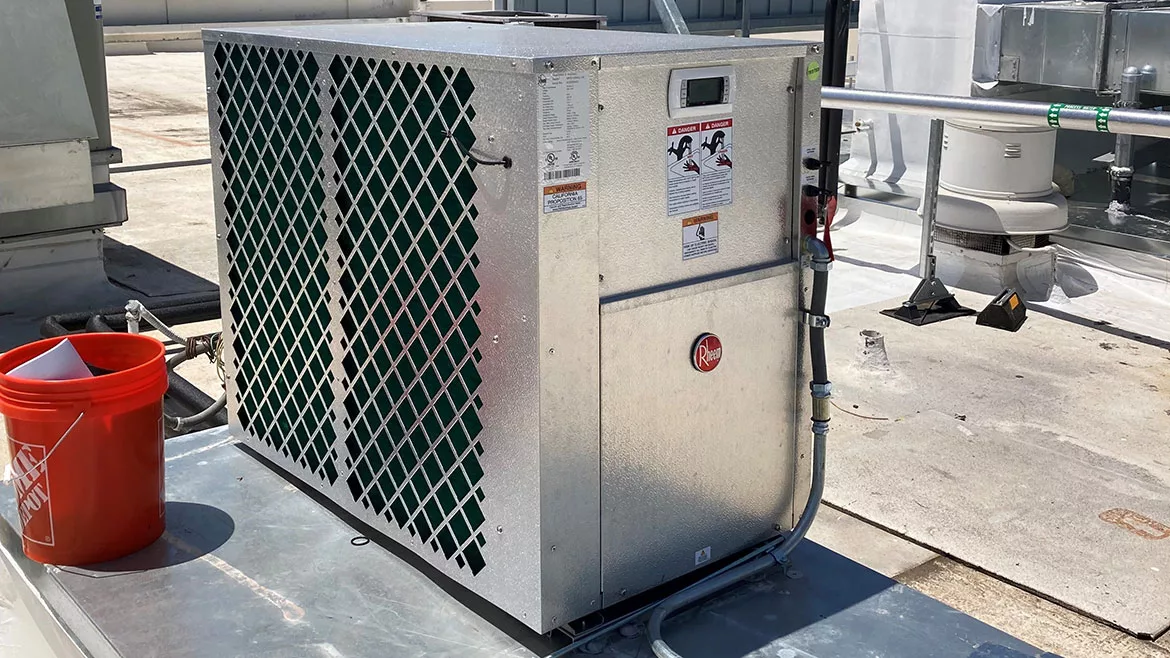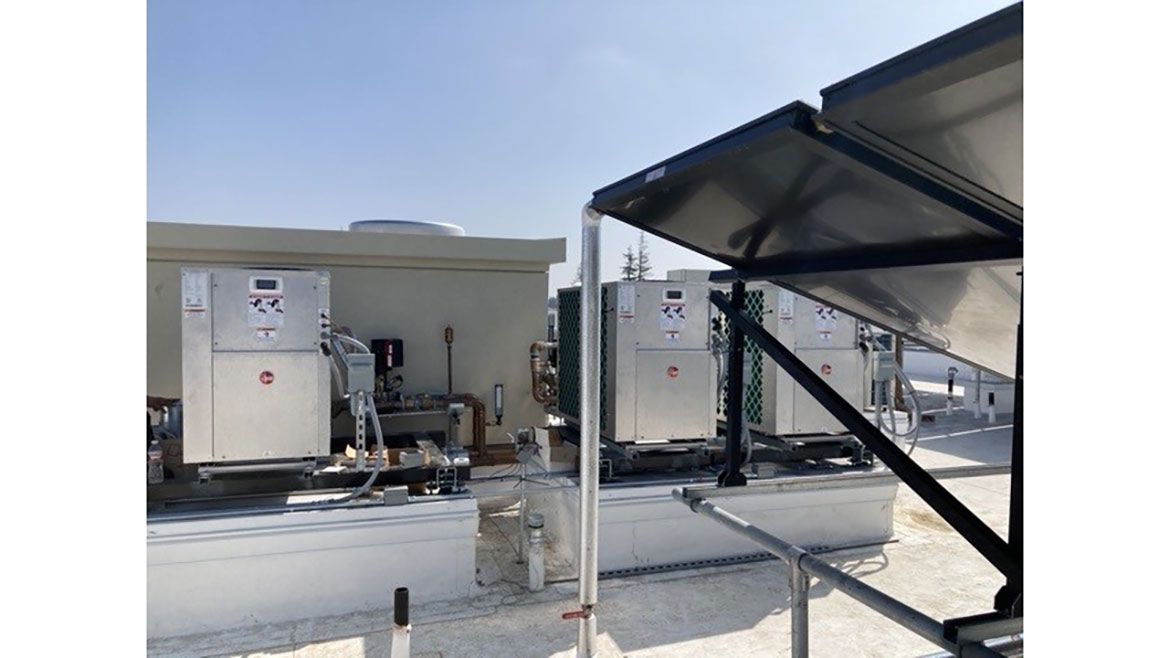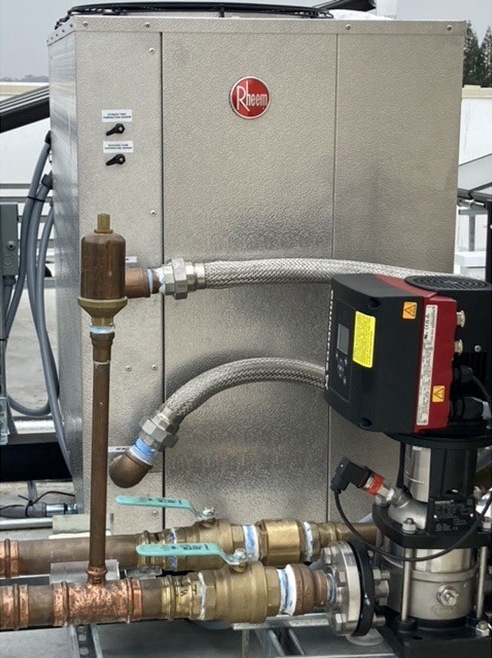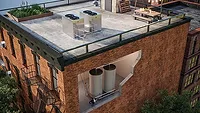Feature
Why heat pump water heaters are the smart choice for businesses
Three reasons to choose a heat pump water heater.

Innovations in heat exchangers and compressor designs now allow HPWHs to operate effectively in a wider range of temperatures, addressing earlier concerns about performance in colder climates. Photo courtesy of Rheem Manufacturing
As businesses worldwide increasingly prioritize sustainability, energy efficiency and reducing carbon emissions, the demand for environmentally friendly solutions has grown. Across the U.S., state and local policymakers are seeking ways to better the climate through building codes and other policies that require or promote net-zero energy and building electrification. One key energy-focused element of many commercial operations is water heating. Commercial heat pump water heaters (HPWHs) offer a compelling solution to those seeking energy efficiency.
Air-to-water heat pumps offer a unique advantage by utilizing readily available heat from the air, making them far more efficient than traditional heating systems. In regions like the Northeast, there are building regulations such as ASHRAE 62.1, which requires a certain volume of fresh air for occupancy, this technology shines. Buildings need to bring in cold outside air, condition it and then exhaust it, losing valuable energy in the process. However, heat pumps can capture this conditioned air before it is exhausted, using the residual heat to warm water and support the building’s needs. This process not only conserves energy but also makes use of heat that would otherwise be wasted, which is why installation of a HPWH in a non-traditional space can prove beneficial. By installing a HPWH in a space that is noticeably warm, such as an IT room, heat pump systems can provide an even higher level of efficiency. Overall, this approach significantly reduces the reliance on natural gas or electric heating elements, which offer lower efficiencies, whereas heat pumps can deliver much higher energy savings even in cold conditions.
In this article, we’ll explore three reasons why commercial heat pump water heaters are a smart investment for businesses.

Modern HPWHs come with advanced controls and monitoring systems that provide real-time data on energy consumption and system performance. This allows facility managers the ability to optimize the system, ensuring it runs at peak efficiency. Photo courtesy of Rheem Manufacturing
Long-term savings and incentives
Investing in commercial heat pump water heaters often involves more upfront costs compared to traditional systems. This includes the cost of equipment and the installation requirements, such as new piping and additional space for storage tanks. However, this initial outlay should be viewed in the context of a building's long lifespan. Buildings often stand for decades, if not centuries, and the initial infrastructure investment pays off over time.
Heat pumps operate at efficiencies up to four times greater than conventional boilers or electric heaters. This means they use less energy to produce the same amount of hot water, leading to significant operational savings. While a heat pump might have a lifespan of around 10 to 20 years, the infrastructure — once installed — does not need to be replaced with each new unit. Future replacements become economical because the modifications are already in place.

Commercial heat pump water heaters (HPWHs) offer a compelling solution to those seeking energy efficiency. Photo courtesy of Rheem Manufacturing
Operational savings aren't the only financial benefits. Governments and utilities are offering incentives to encourage the adoption of energy-efficient technologies. One such strategy is load-shifting, where businesses are incentivized to use electricity during off-peak hours, such as overnight when there is less activity taking place in commercial buildings. Heat pump systems are well-suited for this because they can heat water during these periods and store it for later use. This not only reduces energy costs but also helps balance the demand on the electrical grid.
For example, the TECH Clean California initiative offers rebates to businesses that implement load-shifting technologies with heat pump water heaters. By heating water during times when electricity is less in demand, companies can take advantage of lower energy rates and receive financial incentives for easing grid stress.
Environmental impact
Commercial air-to-water heat pumps provide notable environmental benefits by reducing cooling loads in warmer months and optimizing existing heat sources. By efficiently extracting and redistributing ambient heat, HPWHs can reduce the cooling load on the systems, cutting energy use for cooling while heating domestic water. This makes them essential for meeting stricter environmental regulations focused on reducing carbon emissions.
Accurate system sizing is another crucial aspect of maximizing the environmental and operational benefits of HPWHs. Oversizing systems to handle peak demand can reduce efficiency, wear out equipment faster, and increase costs. A holistic approach is needed, treating HPWHs as part of a larger system. This approach takes into account the building’s actual energy needs and usage patterns while optimizing the heat pump's performance to ensure a greater overall efficiency.

Rheem continues to stay ahead of the curve by helping businesses by using their years of experience in the water heating industry to analyze hot water demands around a building’s application to fully leverage heat pump technology. Photo courtesy of Rheem Manufacturing
Another factor to remember is the introduction of new refrigerants, particularly CO2 (R-744), which aims to replace traditional refrigerants that have high global warming potential (GWP). While CO2-based heat pumps are more environmentally friendly due to their lower GWP, they operate at significantly higher operating pressures, ranging from 900 to 1,400 PSIG, in contrast to the R410A 360 to 400 PSIG typical of conventional systems. The necessity for technicians to possess the appropriate skills and knowledge to safely manage these high-pressure systems is of the utmost importance. The lack of adequate training for the workforce could lead to challenges in servicing and maintaining these advanced systems.
As businesses shift toward electrification in their decarbonization efforts, the role of utility providers becomes crucial. The transition from traditional gas systems to solutions like heat pumps creates a need for higher grid capacity. A collaborative approach between businesses and utility providers is essential to ensure that this transition occurs smoothly and without overburdening the grid. The timing and coordination between industries, regulators, and utilities are critical to a sustainable and efficient electrification strategy.
Technological advancements
Innovations in heat exchangers and compressor designs now allow HPWHs to operate effectively in a wider range of temperatures, addressing earlier concerns about performance in colder climates.
Another key development is the ability to integrate HPWHs into a building’s broader energy management system. Newer models are designed to work in tandem with HVAC and domestic hot water systems, allowing buildings to redistribute heat where it's needed most. This approach reduces overall energy consumption by utilizing existing heat sources rather than generating new energy. For example, heat generated by servers or other equipment can be harnessed to support hot water needs, maximizing the system’s efficiency.
Moreover, modern HPWHs come with advanced controls and monitoring systems that provide real-time data on energy consumption and system performance. This allows facility managers the ability to optimize the system, ensuring it runs at peak efficiency. The ability to monitor and adjust system parameters remotely provides a level of operational flexibility that was previously unavailable, helping businesses save on both energy use and maintenance costs.
It’s safe to say that HPWHs are here to stay. One important factor for contractors and plumbers to remember is that HPWHs are not standalone units — they require integrated planning to maximize efficiency and cost savings. A strategic, long-term approach is key. While the initial investment may be higher, the significant reduction in energy consumption and operational costs more than justifies the expense over time.
Factoring in government incentives and rebates is also vital when evaluating the financial impact of HPWH installations. These incentives can substantially offset upfront costs, making the transition to heat pump technology even more attractive.
Now is the time for businesses to consider transitioning to heat pump technology for domestic hot water.
Looking for a reprint of this article?
From high-res PDFs to custom plaques, order your copy today!








